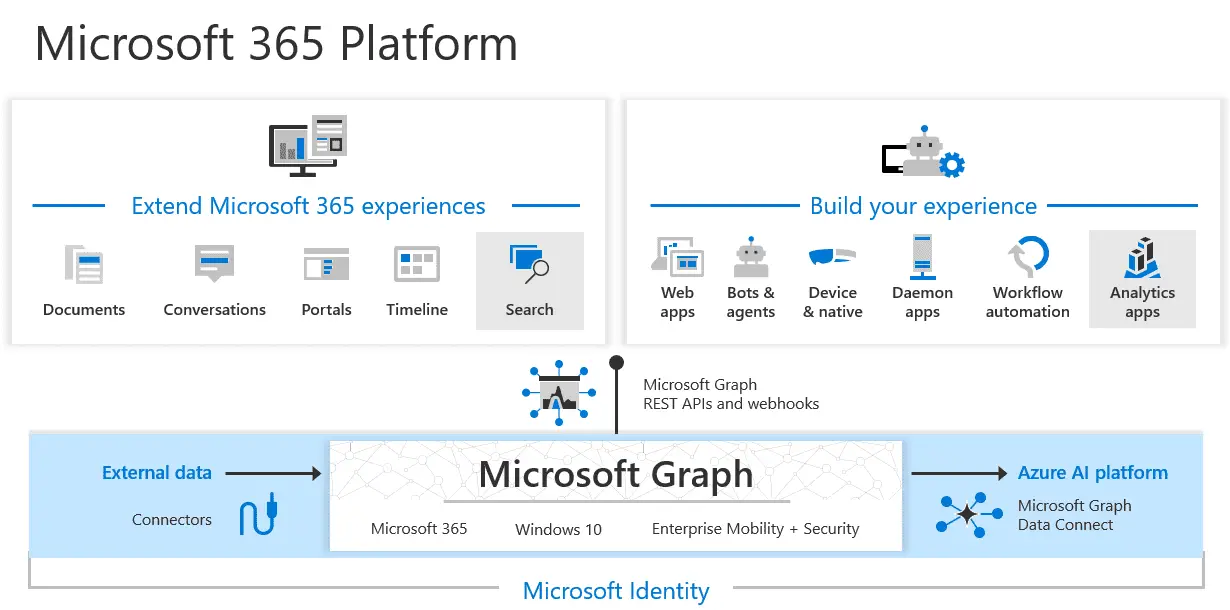
Microsoft Graph | Image: Microsoft
A new trend is gaining momentum among cybercriminals—utilizing Microsoft’s Graph API for sinister purposes. This trend highlights a shift in how attackers orchestrate their campaigns, opting for less conspicuous methods by exploiting widely trusted cloud services. A recent report from Symantec’s Threat Hunter Team sheds light on this evolving threat landscape, particularly how the Microsoft Graph API is being used to facilitate communications with command-and-control (C&C) servers hidden within Microsoft’s cloud infrastructure.

The Microsoft Graph API is a powerful tool designed to integrate various services and data across Microsoft 365. It supports a wide array of functionalities, from accessing emails and calendars to managing devices and cloud files. However, its very utility makes it an attractive vector for cyber attackers. By masquerading malicious traffic as legitimate API calls to services like OneDrive, attackers can evade traditional detection mechanisms.
Ukrainian Attack Spotlights “BirdyClient” Threat
The utilization of the Graph API for malicious purposes was starkly illustrated in an attack against an organization in Ukraine. The malware, dubbed “BirdyClient” or “OneDriveBirdyClient,” ingeniously used Microsoft OneDrive, manipulated via the Graph API, as a command-and-control server. This previously undocumented malware masqueraded as a legitimate file, vxdiff.dll, potentially sideloading through an associated legitimate application, thereby complicating detection efforts.
The API as a Double-Edged Sword
The Microsoft Graph API is a powerful asset for integrating data and services across the Microsoft 365 ecosystem. However, in the hands of cybercriminals, it becomes a dangerous double-edged sword. Here’s why attackers are drawn to it:
- Stealthy Communications: Malicious traffic slips past defenses, disguised amidst the bustle of legitimate Microsoft service usage.
- Undermining Trust: The inherent trust in Microsoft platforms provides perfect camouflage for nefarious activity.
- Freemium Exploitation: Basic accounts on OneDrive and similar services offer threat actors cheap and accessible C&C infrastructure.
A Trend with Ominous Origins
Sadly, BirdyClient is not an isolated incident. Reports indicate state-sponsored hacking groups pioneered this Graph API abuse tactic years ago. The infamous North Korean APT37 used it, followed by a roster of sophisticated espionage groups across the globe. Now, the relative ease of access is fueling its adoption by a wider range of attackers.
From the early adoption by specialized espionage groups to its broader application in widespread cyber attacks, the use of the Graph API reflects a significant shift in attack methodologies. Tools like “GraphStrike,” developed for penetration testing, highlight both the potential and the risks associated with this method. These tools enable even more sophisticated attacks, such as integrating the Cobalt Strike Beacon payload to use the Graph API for HTTPS command-and-control communications.
The Challenge for Defenders
The exploitation of the Graph API throws a wrench into traditional threat detection models. Security teams can no longer afford to whitelist traffic solely based on its association with reputable cloud services. To combat this evolving tactic, organizations must adopt:
- Intense Scrutiny: Analyze API usage patterns for anomalies, even within seemingly normal Microsoft traffic flows.
- Data Exfiltration Monitoring: Implement tools to detect unusual data transfers, especially to cloud storage platforms.
- Proactive Threat Intelligence: Stay ahead of the curve by actively researching and understanding the latest attack methods and indicators of compromise.
The Era of Cloud-Based Warfare
The misuse of the Microsoft Graph API is a stark manifestation of the cybersecurity arms race. It underscores the fragility of trust in an increasingly cloud-centric world. As attackers continue to refine their techniques, security teams must remain vigilant and evolve their defenses to meet the challenges head-on.